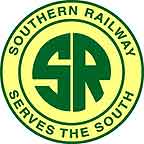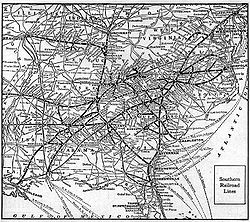Southern Railway (U.S.)
 | |
| Overview | |
|---|---|
| Headquarters | Washington, D.C. |
| Reporting mark | SOU |
| Locale | U.S. Southern states |
| Dates of operation | 1894–1982 |
| Successor | Norfolk Southern |
The Southern Railway (reporting mark SOU) is a former United States railroad. It was the product of nearly 150 predecessor lines that were combined, reorganized and recombined beginning in the 1830s, formally becoming the Southern Railway in 1894. It was placed under control of the Norfolk Southern Corporation, along with the Norfolk and Western Railway (N&W), in 1982, and was renamed Norfolk Southern Railway in 1990. (The N&W continued to exist as a subsidiary until 1998.)
History


The pioneering South Carolina Canal and Rail Road Company, Southern's earliest predecessor line and one of the first railroads in the United States, was chartered in December 1827 and ran the nation's first regularly scheduled steam powered passenger train – the wood-burning Best Friend of Charleston – over a six mile section out of Charleston, South Carolina, on December 25, 1830. (The Baltimore and Ohio Railroad ran regular passenger service earlier that year.) By 1833, its 136-mile line to Hamburg, South Carolina, was the longest in the world.
As railroad fever struck other Southern states, networks gradually spread across the South and even across the Allegheny Mountains. Charleston, South Carolina, and Memphis, Tennessee, were linked by 1857, although rail expansion halted with the start of the Civil War. The Richmond and York River Railroad, which operated from the Pamunkey River at West Point, Virginia to Richmond, Virginia, was a major focus of George McClellan's 1862 Peninsular Campaign, which culminated in the Seven Days Battles and devastated the tiny rail link. The Richmond and Danville Railroad was the Confederacy's last link to Richmond, and transported Jefferson Davis and his cabinet to Danville, Virginia just before the fall of Richmond in April, 1865.

Known as the "First Railroad War," the Civil War left the South's railroads and economy devastated. Most of the railroads, however, were repaired, reorganized and operated again. In the area along the Ohio River and Mississippi River, construction of new railroads continued throughout Reconstruction. The Richmond and Danville System expanded throughout the South during this period, but was overextended, and came upon financial troubles in 1893, when control was lost to financier J.P. Morgan, who reorganized it as the Southern Railway System.
Southern Railway, as it came into existence in 1894, was a combination of the Richmond and Danville system and the East Tennessee, Virginia and Georgia Railroad. The company owned two-thirds of the 4,400 miles of line it operated, and the rest was held through leases, operating agreements and stock ownership. Southern also controlled the Alabama Great Southern and the Georgia Southern and Florida, which operated separately, and it had an interest in the Central of Georgia.
Southern's first president, Samuel Spencer, drew more lines into Southern's core system. During his 12-year term, the railway built new shops at Knoxville, Tennessee, and Atlanta, Georgia and purchased more equipment. He moved the company's service away from an agricultural dependence on tobacco and cotton and centered its efforts on diversifying traffic and industrial development. Sadly, Spencer was killed in a train wreck in 1906.
By the time the line from Meridian, Mississippi, to New Orleans, Louisiana was acquired in 1916 under Southern's president Fairfax Harrison, the railroad had attained the 8,000-mile, 13-state system that marked its territorial limits for almost half a century.
The Central of Georgia became part of the system in 1963, and the former Norfolk Southern Railway was acquired in 1974.
Notable features
Southern and its predecessors were responsible for many firsts in the industry. Starting in 1833, its predecessor, the South Carolina Canal and Rail Road, was the first to carry passengers, U.S. troops and mail on steam-powered trains,[1] and it was the first to operate at night.[citation needed]
The Southern Railway was notably the first Class I railroad in the United States to completely convert to diesel motive power.[citation needed] On June 17, 1953, the railroad's last steam-powered freight train arrived in Chattanooga, Tennessee behind 2-8-2 locomotive No. 6330.
From dieselization and shop and yard modernization, to computers and the development of special cars and the unit coal train, Southern often was on the cutting edge of change, earning the company its catch phrase, "Southern Gives a Green Light to Innovation."[citation needed]
Every hood unit locomotive Southern owned was ordered with a high hood and operated long hood forward for crew safety in case of accidents with vehicles. From the first GP7 to the last GP50, they came with this option until the tradition stopped with the SD50.[citation needed]
In the early 1960s, a popular steam locomotive excursion program was instituted under the presidency of W. Graham Claytor Jr. The steam program survived the merger which formed the new Norfolk Southern Railway in 1982, but was finally discontinued in 1994.
Named trains
- Aiken-Augusta Special
- Asheville Special
- Birmingham Special
- Carolina Special
- Crescent
- Florida Special
- Peach Queen
- Pelican
- Piedmont Limited
- Ponce de Leon
- Royal Palm
- Southerner
- Sunnyland
- Tennessean
Merger into Norfolk Southern
In response to the creation of CSX in 1980, the Southern Railway merged with Norfolk and Western Railway to form the Norfolk Southern Railway in 1982, further consolidating railroads in the eastern half of the United States.
Roads owned by the Southern Railway
- Alabama Great Southern Railroad (AGS)
- Central of Georgia Railway (CofG)
- Cincinnati, New Orleans and Texas Pacific Railway (CNO&TP)
- Georgia and Florida Railroad (G&F)
- Georgia Northern Railway (GANO) — acquired in 1967
- Georgia Southern and Florida Railway (GS&F)
- Knoxville and Charleston Railroad
- Louisiana Southern Railway (LS)
- New Orleans and North Eastern Railway (NO&NE)
- New Orleans Terminal Company (NOTCO)
- Tennessee, Alabama and Georgia Railway (TA&G)
Major railroad yards
- Chattanooga, Tennessee – DeButts Yard (formerly Citico Yard)
- Atlanta, Georgia – Inman Yard
- Linwood, North Carolina – Spencer Yard
- Birmingham, Alabama – Norris Yard
- Knoxville, Tennessee – Sevier Yard
- Macon, Georgia – Brosnan Yard
- Sheffield, Alabama – Sheffield Yard
Company officers
Presidents of the Southern Railway:
- Samuel Spencer (1894–1906)[2]
- William Finley (1906–1913)
- Fairfax Harrison (1913–1937)
- Earnest E. Norris (1937–1951)
- Harry A. deButts (1951–1962)
- D. William Brosnan (1962–1967)
- W. Graham Claytor Jr. (1967–1977)[3][4]
- L. Stanley Crane (1977–1980)
- Harold H. Hall (1980–1982)
See also
References
- Norfolk Southern Railway. Retrieved February 22 2005.
- Named Trains
- ^ Brown, William H. (1871). "Chapter XXIX: Explosion of "Best Friend"". The History of the First Locomotives in America; From Original Documents And The Testimony Of Living Witnesses. New York: D. Appleton and Company. Retrieved 2008-05-28.
{{cite book}}: External link in|chapterurl=|chapterurl=ignored (|chapter-url=suggested) (help) - ^ "The History of the railroad and Spencer". North Carolina Transportation Museum. Retrieved 2007-01-25.
- ^ White, John H. Jr. (Spring 1986). "America's Most Noteworthy Railroaders". Railroad History. 154: 9–15. ISSN 0090-7847. JSTOR 43523785. OCLC 1785797.
- ^ quotes from article by journalist Don Phillips of the Washington Post in a "Tribute to W. Graham Claytor, Jr." published May, 1994
External links
- Norfolk Southern company website
- Southern Railway Historical Association covers Southern Railway history
- Virginia Museum of Transportation located in Roanoke, VA
- Johnson's Depot: Railway History of Johnson City,TN
- Railroad lines abandoned by the Southern Railway
- Annual Report of Southern Railway Company in Mississippi (MUM00010) at The University of Mississippi.
- Articles lacking sources from May 2008
- Southern Railway (US)
- Predecessors of the Norfolk Southern Railway
- Former Class I railroads in the United States
- Defunct Alabama railroads
- Defunct Florida railroads
- Defunct Georgia (U.S. state) railroads
- Defunct Mississippi railroads
- Defunct Tennessee railroads
- Railway companies established in 1894
- Railway companies disestablished in 1990
